![]()
| Vietnam | Sapa | 2002.04.17 - 04.26 |
Hill Tribes
Sapa is a growing town in the hills in Northern Vietnam. About 10 ethnic tribes spot the hills in and around Sapa. Each tribe has a unique dress, culture, and language. With the increase in tourism, many hill tribe girls speak better English than Vietnamese. Some sell hand embroidered fabrics, silver jewelry, and musical instruments to tourists. Others work as trekking guides for hotels and travel agents.
Multiple ethnic groups can be seen by strolling around town for the day.
A single or multiple-day trek through surrounding hill tribe villages
is an experience few places in the world can provide. During our stay, we
created a website for a hotel in Sapa.
www.atwtravel.net/mountainview/
View it for details on activities and additional photos.
HILL TRIBE TREKS
Treks from the center of Sapa to hill tribe villages range from simple
walks lasting a few hours to multiple-day long distance treks. Some
walks are led by Vietnamese who speak English well. Others are led by
H'mong girls who's English skills range from moderate to decent.
We enjoyed walks led by a H'mong girl for several reasons:
Comparatively, the Vietnamese guides cannot communicate with the hill tribes and often recite information from memorization rather than direct experience.
Treks in Sapa arranged in Hanoi carry a US$20~$30 / person surcharge and come with a Vietnamese guide who may not know much about the hill tribe culture. Traveling to Sapa on one's own and arranging treks in town are best. See the Mountain View Hotel's website (www.atwtravel.net/mountainview/) for an overview of Sapa trekking options.
MARKETS
The most colorful market is the Sunday Bac Ha Market. Day trips from Sapa depart
every Sunday morning. Flower H'mong are the most prevalent tribe at the market. With
their colorful dress, Bac Ha is an ideal photo location.
HOW FAR DOES $100 GO?
For part of the year each year, San Diego, California resident Peter Rambo opens a medical
clinic for the Sapa area people. All medicine and equipment are funded out of Peter's
personal savings and other's personal contributions. Some hill tribe people walk for days
to seek Peter's medical attention. Those who need more than medication, disinfection,
and bandaging are transported to and treated at a proper hospital in Lao Cai, all
funded from Peter's meager budget. Severe cases are further transported to Hanoi,
another 14 hours by train distant.
In a society where family incomes are US$1 per day, Peter's volunteer work can be a godsend. Last week, a blind man was guided by his grandson for 3 days to Peter's clinic. The cause of blindness was cataracts. Peter called ahead to Lao Cai. The cost was 1,000,000 VND (about US$65) per eye for cornea replacement. For US$130, Peter gave this man his vision. How far did your last $100 go?
Donations of cash, medicine, bandages, and simple medical equipment can be sent to Peter at:
Peter Rambo
5156 Solar Street
San Diego, CA 92110
USA
email: rambopeter@hotmail.com
Note: Peter is not registered as a charity and cannot return US tax deductible receipts for contributions.
GETTING THERE
2 night trains depart Hanoi for Lao Cai. Connecting minibuses for Sapa await on the
Lao Cai train platform and in the train station parking lot. Fares on all minibuses
are identical.
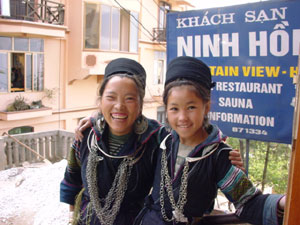 |
Girls from the Black H'mong tribe hang out at our hotel entrance. Some sell hand embroidered cloth from their village. Others work as trekking guides for the hotels and tour agencies. |
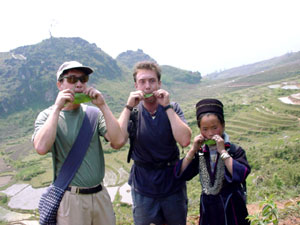 |
Our trekking guide Mai blows tunes on a leaf. Lenny and Wes try to imitate... in vain. |
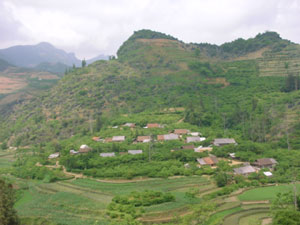 |
Treks through surrounding villages have excellent scenery and friendly villagers. |
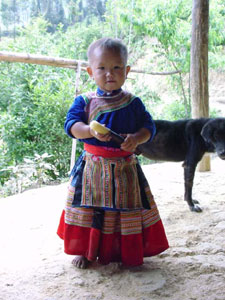 |
A Flower H'mong baby poses at his village house. Wes took the photo on a digital camera and immediately displayed the image to the baby saying, "That's you!" The baby repeated, "Das-oo". |
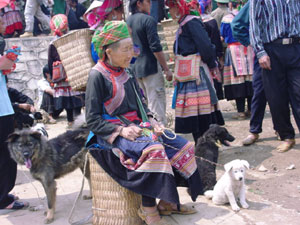 |
An old Flower H'mong woman sits at the Bac Ha Market trying to sell her dog. The large dogs are sold for their meat and the puppies are sold for breeding. None are sold as pets. |
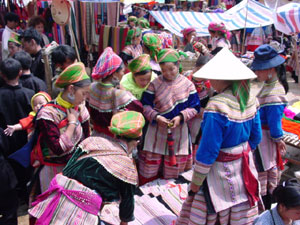 |
Young Flower H'mong women look at colorful cloth for clothing at Bac Ha Market. |
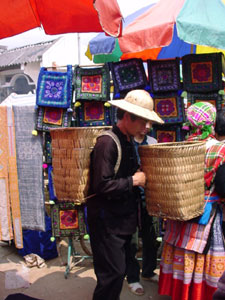 |
A hill tribe man scouts the weekly Bac Ha Market for goods to carry home. Shoulder baskets, including their straps are constructed entirely of fibers. |
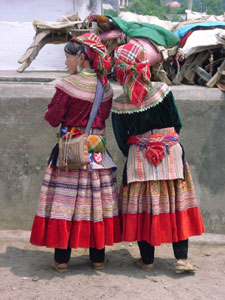 |
Flower H'mong girls face away from the crowded marketplace enjoying their popsicles. |
Copyright © 2000-2002 Wes and Masami Heiser. All rights reserved.